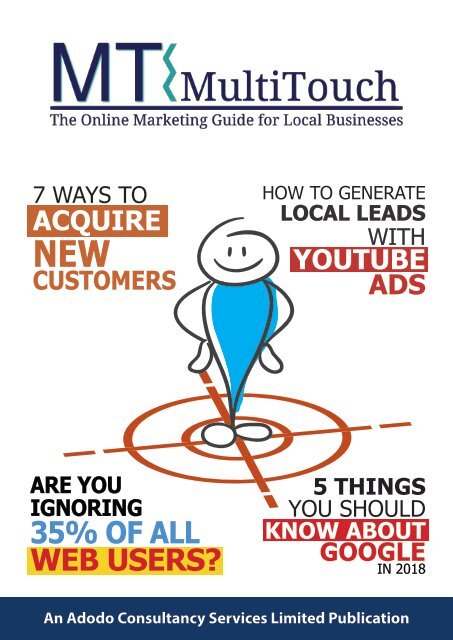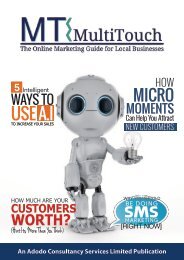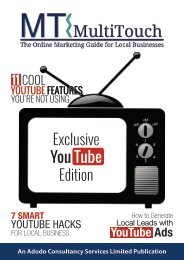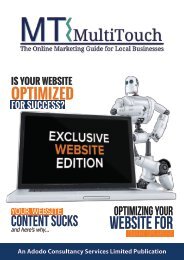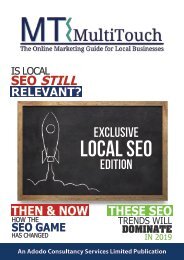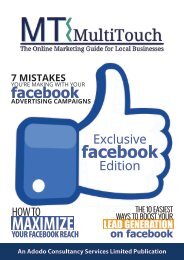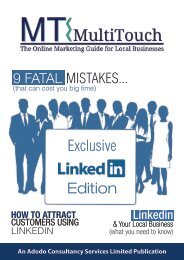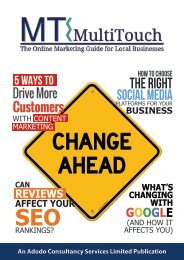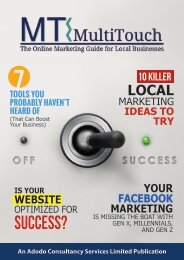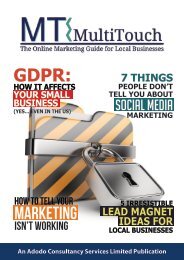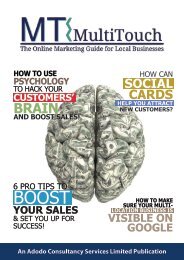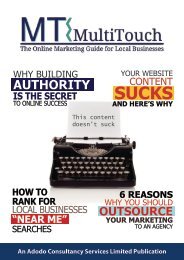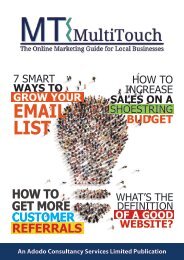mt-magazine-Mar18
Create successful ePaper yourself
Turn your PDF publications into a flip-book with our unique Google optimized e-Paper software.
7 WAYS TO<br />
ACQUIRE<br />
NEW<br />
CUSTOMERS<br />
HOW TO GENERATE<br />
LOCAL LEADS<br />
WITH<br />
YOUTUBE<br />
ADS<br />
ARE YOU<br />
IGNORING<br />
35% OF ALL<br />
WEB USERS?<br />
5 THINGS<br />
YOU SHOULD<br />
KNOW ABOUT<br />
GOOGLE<br />
IN 2018<br />
An Adodo Consultancy Services Limited Publication
Contents<br />
7 Ways to Acquire New<br />
Customers<br />
A stagnating business is more likely<br />
to fail than one that’s growing. That’s<br />
just common sense. Businesses that<br />
experience new growth – in the<br />
form of new customers – have an<br />
advantage over businesses that are barely managing to hold onto<br />
their existing customers. But attracting new customers is a must.<br />
And it can be expensive. Up to 10 times as costly as retaining an<br />
existing customer. But luckily for you not all customer-attraction<br />
methods are expensive. Here are seven low-cost ways to acquire<br />
new customers and grow your business.<br />
Are You Ignoring 35% of All<br />
Web Users?<br />
If you tend to keep up with SEO and<br />
search trends, then you know that<br />
almost everything focuses on Google.<br />
And why not? Google is by far the<br />
largest search engine, snagging about<br />
two-thirds of all searchers. But one-third of all searches aren’t<br />
using Google. And that’s good news for you, because you (the well<br />
informed business owner) can get a leg up on your competition<br />
with a little bit of legwork. Sounds pretty good, right? Let’s get<br />
into to it…<br />
How to Generate Local Leads<br />
with YouTube Ads<br />
Most small businesses don’t have a<br />
huge marketing budget. Sound familiar?<br />
We get it. Advertising is expensive.<br />
You want the money you spend<br />
to stretch as far as possible – and that<br />
means finding advertising opportunities that are going to get<br />
you the biggest possible bang for your buck. There’s no shortage<br />
of options. But YouTube Ads remain a very underutilized<br />
option for business owners. And when it comes to generating<br />
leads, these ads seem to be CRUSHING it for business owners in<br />
the know.<br />
5 Things You Should Know About<br />
Google in 2018<br />
If people can’t find your website,<br />
they’re not going to buy from you.<br />
It’s internet marketing 101. You can’t<br />
expect people to purchase your products<br />
or try your services if you’re invisible<br />
to them. Google is the world’s top search engine. Essentially<br />
that means that getting a high rank on Google can make or break<br />
your business. Here are the 5 things you need to know to improve<br />
your site’s rank and rise to the top of Google.<br />
Welcome To MT<br />
Thanks for checking out the latest<br />
edition of MT, your online marketing<br />
resource guide for local businesses.<br />
Each month we will be covering topics<br />
that resonate with local businesses<br />
just like yours.<br />
Our goal is simple. We want to<br />
enable you to do big things online,<br />
and it all starts by breaking down<br />
the complexities of marketing your<br />
business online.<br />
It doesn’t matter if you are just starting<br />
out, or an established business owner<br />
in your local community, you can<br />
always benefit from increasing your<br />
brand’s visibility online.<br />
To your Success,<br />
Tim Glynn<br />
CEO and head of fun<br />
MT IS BROUGHT TO YOU BY<br />
Adodo Consultancy Services, the leading<br />
small business marketing service dedicated<br />
to putting reputation marketing at the heart<br />
of a local businesses marketing strategy. We<br />
help small businesses connect with more<br />
customers online.<br />
If you want to build your business, you need<br />
to market, it’s that simple. But you can lose<br />
thousands of dollars if you don’t know what<br />
you are doing. So we urge you to take action<br />
with some of the strategies we recommend.<br />
Feel free to reach out to us at any time.
7 WAYS TO ACQUIRE<br />
NEW CUSTOMERS<br />
A stagnating business is more likely to fail than<br />
one that’s growing.<br />
I mean, let’s face it. That’s just common sense.<br />
Businesses that experience new growth – in<br />
the form of new customers – have an advantage<br />
over businesses that are barely managing<br />
to hold onto their existing customers.<br />
That’s not to say that customer retention doesn’t<br />
matter. It does! But attracting new customers is<br />
a must. And it can be expensive. In fact, research<br />
shows that attracting a new customer can be<br />
up to 10 times as costly as retaining an existing<br />
customer.<br />
But…<br />
That doesn’t mean you shouldn’t try. And, not<br />
all customer-attraction methods are necessarily<br />
expensive.<br />
Here are seven (relatively) low-cost ways to acquire<br />
new customers and grow your business.
#1<br />
UPDATE YOUR AUDIENCE RESEARCH<br />
#2<br />
KNOW YOUR COMPETITION<br />
I’m always amazed when I talk to business<br />
owners and they tell me that the last time they<br />
conducted audience research was years ago.<br />
That’s crazy. Audiences change. You’ve got to<br />
know who’s interested in your products – and<br />
why they’re interested – if you’re going to understand<br />
how to bring your audience to your<br />
site.<br />
If it’s been a while since you conducted any<br />
audience research, it’s time to get back on the<br />
horse. For example, you can:<br />
> Check your analytics and look for new<br />
trends<br />
> Create a customer survey and email it to<br />
your list<br />
> Do a social media survey<br />
Competitor research is another key component<br />
of customer acquisition. After all, you and<br />
your competitors are vying for the same audience.<br />
Knowing what they do and how they’re<br />
doing it can help you pull ahead in the race for<br />
new business.<br />
A couple of easy tactics to use include:<br />
> Tracking your competitor’s backlinks<br />
and traffic<br />
> Monitoring your competitor’s social<br />
mentions<br />
> Doing a complete audit of their websites<br />
> Reading their blog and other marketing<br />
materials<br />
Ongoing competitor research will ensure that<br />
you’re not losing out to your competitors.<br />
These things will help you fine-tune your targeting.<br />
You can also use them to create (or<br />
update) a customer persona or avatar to help<br />
you with your marketing.
#3<br />
FOCUS ON BENEFITS, NOT FEATURES<br />
#4<br />
BUILD TRUST WITH YOUR<br />
TARGET AUDIENCE<br />
Another common mistake business owners<br />
make is getting too wrapped up in their product’s<br />
cool features at the expense of considering<br />
the customer’s experience.<br />
Let’s face it. A potential customer doesn’t want<br />
to hear you brag about how awesome your<br />
product is. They want to know what it’s going<br />
to do for them.<br />
Don’t tell them that a frying pan has a nonstick<br />
surface. Tell them that it will simplify their<br />
clean-up! That’s a simple example, but it illustrates<br />
the point.<br />
You can list your products features briefly, but<br />
most of your marketing should focus on benefits.<br />
Think about your customer (see #1) and<br />
the problem they want solved. Then, explain<br />
how your product will solve it.<br />
If you know anything about marketing, then<br />
you know about the Rule of 7. It says that, on<br />
average, a customer must have seven interactions<br />
with your brand before they’ll buy from<br />
you.<br />
The key to building trust is to use those seven<br />
“touches” wisely. You’ll need to be consistent.<br />
That means knowing your audience, having a<br />
clear vision for your brand, and using the same<br />
voice for all your online content, whether it’s<br />
on your website or social media.<br />
And speaking of social media, it’s ideal for<br />
building trust. You can connect with your<br />
followers every day without seeming overly<br />
sales-y or obnoxious.
#5<br />
PAIR WITH OTHER BUSINESSES<br />
#6<br />
CREATE A REFERRAL PROGRAM<br />
You can’t expect your direct competitors to<br />
refer business to you. That would be counterproductive<br />
for them. But that doesn’t mean<br />
that B2B referrals aren’t possible.<br />
Try searching for businesses in your niche – or<br />
in a related niche – that aren’t in direct competition<br />
with you. Then, approach the owners<br />
about the potential for a reciprocal referral<br />
program or joint venture.<br />
For example, if you sell dog training products<br />
and there’s a company that sells cleaning<br />
products for people with pets, you could pair<br />
up to create special offers and referrals. You<br />
might link to their site and have them link to<br />
yours, and you could even create limited time<br />
offers and specials.<br />
The key is that you’ll get access to their customer<br />
base and they’ll get access to yours –<br />
and you probably won’t have to spend anything<br />
to do it.<br />
It’s important not to ignore your current customers<br />
as ambassadors for your brand. After<br />
all, who’s in a better position to tell new customers<br />
about the benefits of buying from you?<br />
The key is not to assume that your existing<br />
customers will spread the word about you<br />
and your products. They might do it without<br />
prompting, but why not make it easy for them?<br />
A strong referral program can bring you snew<br />
business on a regular basis.<br />
Many referral programs incentivize referrals.<br />
For example, you might offer customers a free<br />
product (or a free month of service) in return<br />
for a referral. Or, you might host a special event<br />
for customers who refer new business to you.<br />
Make sure to specify the terms of any rewards<br />
and to provide customers with what they<br />
need to make referrals, whether it’s a supply<br />
of business cards or brochures or a dedicated<br />
URL on your website.
#7<br />
CREATE SHAREABLE COUPONS<br />
AND OFFERS<br />
A referral program is one<br />
thing. But what if you could<br />
convince your existing social<br />
media followers to spread the<br />
word about your products in<br />
return for a simple coupon?<br />
You can! The next time you’re<br />
running a promotion, encourage<br />
your followers to share<br />
it. Your call to action can say<br />
something like, “Why keep all<br />
the savings for yourself?<br />
Share this post with your<br />
friends and family so they can<br />
get a bargain, too!”<br />
The key is not to assume that<br />
people will share your content.<br />
They may not know that<br />
it’s okay with you for them to<br />
do so – so make sure to ask in<br />
your call to action.<br />
NEW CUSTOMERS AREN’T EVERYTHING...<br />
But, if you want your business to grow, you’ll need to expand<br />
your reach. These 7 simple tips can help you attract new customers<br />
without blowing through your marketing budget.<br />
Instead, you can use them to blow past your competition!
Are you Ignoring 35% of All<br />
WEB USERS?<br />
If you tend to keep up with<br />
SEO and search trends, then<br />
you know that almost everything<br />
focuses on Google. And<br />
why not? Google is by far the<br />
largest search engine, snagging<br />
about two-thirds of all<br />
searchers.<br />
Two-thirds is a lot, but do you<br />
notice what’s missing there?<br />
If you remember what you<br />
learned about fractions, it’s<br />
not that hard.<br />
Got it?<br />
That’s right! One-third of all<br />
searches aren’t using Google.<br />
And yet, amazingly, most<br />
businesses aren’t considering<br />
other search engines at all!<br />
They remain laser-focused on<br />
Google.<br />
That’s good news for you, because<br />
it means that by taking<br />
other options into account,<br />
you can get a leg up on your<br />
competition. Sounds pretty<br />
good, right? So, let’s talk about<br />
it.
WHAT SEARCH ENGINE ARE THE MISSING 35% USING?<br />
If not Google, who?<br />
That’s probably what you’re wondering. You might think<br />
that that elusive 35% is split among several search engines.<br />
That’s right – but it’s also wrong.<br />
You see, as of 2015, Yahoo made a deal with Bing.<br />
Approximately 51% of all Yahoo searches use<br />
Bing. And, since Bing and Yahoo are responsible<br />
for about 35% of all search traffic, that means that<br />
optimizing for Bing can help you capture people<br />
you might miss by thinking only about Google.<br />
Bing and Google have a lot in common. But, if<br />
you search one of your keywords and compare<br />
the SERP, you’ll notice some differences. Addressing those<br />
differences can help you stand out from your competitors.<br />
“<br />
The key is to do it without<br />
messing with your<br />
Google rank.<br />
“
ADVANTAGES OF OPTIMIZING FOR BING<br />
Before we walk through how you can optimize for Bing searches without affecting your Google<br />
rank, let’s talk about the main advantages of optimizing for Bing.<br />
1.<br />
You’ll face less competition<br />
than on Google.<br />
Remember, most businesses<br />
aren’t thinking<br />
about their Bing rank. That<br />
means if you take the time<br />
to optimize for Bing, you<br />
can outrank your competition<br />
and grab the lion’s<br />
share of traffic from Bing<br />
searches.<br />
2. 3.<br />
Traffic from Bing has,<br />
on average, a higher<br />
conversion rate than<br />
traffic from Google. It’s<br />
hard to quantify the reasons<br />
for the difference, but it may<br />
be that Bing users tend to be<br />
older and more affluent than<br />
Google users.<br />
Bing is much more<br />
open about their<br />
ranking factors than<br />
Google. Instead of guessing<br />
about what will help your<br />
site to rank, you can simply<br />
refer to what Bing has said<br />
about it and optimize your<br />
site accordingly. In other<br />
words, they’re pro-SEO.<br />
These things point to a clear opportunity for business owners who want to find a low-cost but<br />
effective way to attract more traffic.<br />
HOW TO IMPROVE YOUR BING RANK<br />
Now, let’s talk about what you<br />
can do to improve your rank on<br />
Bing. Many of the things that<br />
work for you on Google will<br />
also work on Bing. The trick is<br />
to tweak your SEO just a bit, so<br />
your site maintains its Google<br />
rank and moves up on Bing.<br />
MAKE SURE YOUR SITE IS INDEXED ON BING<br />
The first step is to make sure<br />
your site is properly indexed on<br />
Bing. If it’s been around for a<br />
while it probably is, but if your<br />
site is new, it may not be.<br />
Start by doing a search for site:<br />
www.yoursite.com on Bing.<br />
That will show you how many<br />
of your site’s pages have been<br />
indexed.<br />
If they’re indexed, you can<br />
move on to the next step. If<br />
they’re not, you should go<br />
ahead and submit your site<br />
here.
TELL BING HOW OFTEN TO CRAWL YOUR SITE<br />
Next, tell Bing how frequently to crawl your site. If you look at Bing’s Webmaster Tools,<br />
you’ll notice that the default setting is standard. That’s fine if your site is static; but, if it’s<br />
large or you update it frequently, you should dial up the crawl rate for the best results.<br />
SUBMIT A CLEAN SITEMAP<br />
Bing has only a 1% tolerance for dirt in your sitemap.<br />
That means if you want your rank to improve,<br />
you’ve got to clean it up and submit it. You<br />
can do it on your Webmaster Tools page.<br />
Another option is to include a link to your sitemap<br />
in your Robots.txt. However, the benefit of doing<br />
it through Bing is that you’ll<br />
get error messages if there<br />
are problems with your<br />
sitemap. That means you’ll<br />
be able to clean them up<br />
as you go.<br />
USE STRAIGHTFORWARD KEYWORDS<br />
If you know anything about Google, you know<br />
that LSI and context are nearly as important as<br />
keyword use. That’s not the case on Bing. They<br />
put a higher premium on exact keyword matches<br />
than Google does.<br />
Fortunately, this is a change you can make without<br />
hurting your Google rank. You’ll want to increase<br />
your keyword<br />
density a bit, but not so<br />
much that it affects the<br />
quality of your content.<br />
Using those same keywords in<br />
tags – the title tag is hugely important<br />
on Bing – is essential, too.
IMPROVE YOUR CLICK-THROUGH RATE<br />
Bing pays a lot of attention to user behavior. If<br />
users click your site and then hit the back button,<br />
it will affect your Bing rank.<br />
You can check your CTR and bounce rate on<br />
Bing from your Webmaster Tools dashboard.<br />
BUILD MORE BACKLINKS<br />
Google tends to place more emphasis on the<br />
quality of backlinks than the number of them.<br />
Bing does the reverse.<br />
You can’t disregard the quality of your backlinks<br />
without negatively impacting your Google rank.<br />
But, by adding additional backlinks, you can positively<br />
impact your Bing rank.<br />
It’s also a good idea to do what you can to improve<br />
the quality of your anchor text in your<br />
backlinks. Don’t overdo it – that can hurt you<br />
with Google – but contacting a few webmasters<br />
to ask them to use keywords in the anchor text<br />
can help you with Bing.<br />
USE SOCIAL SIGNALS TO YOUR ADVANTAGE<br />
Unlike Google, Bing comes right out and says<br />
that social signals have an impact on the SERP.<br />
That means anything you do to boost your social<br />
media impact will help you with Bing.<br />
The best way to capitalize on this is to monitor<br />
your social signals, attract new followers, and do<br />
whatever you can to amplify your reach on sites<br />
like Facebook and Instagram.<br />
IGNORING BING USERS IS A BAD IDEA...<br />
By taking a few simple steps to boost your Bing ranking, you can out-maneuver your competition.<br />
When you think about it, it makes no sense to simply ignore a third of all searches – so stop doing<br />
it and give Bing the attention it deserves!
HOW TO GENERATE<br />
LOCAL LEADS<br />
WITH YOUTUBE ADS<br />
Most small businesses don’t have a huge marketing budget.<br />
Sound familiar, right? Advertising is expensive. You<br />
want the money you spend to stretch as far as possible –<br />
and that means finding advertising opportunities that are<br />
going to get you the biggest possible bang for your buck.<br />
There’s no shortage of options. And one option that you<br />
may have overlooked is something that you’ve probably<br />
spent a lot of time on as a consumer.<br />
I’m talking about YouTube ads.<br />
ly. Sound about right? And when<br />
you do, you’ve seen the ads that<br />
run before videos. You’ve probably<br />
also noticed ads that display with<br />
your search results.<br />
Well…<br />
When it comes to generating<br />
leads, those ads are CRUSHING it.<br />
You probably visit YouTube often – maybe you even dai
YOUTUBE AD STATISTICS<br />
Let’s start by checking the numbers. We’re<br />
warning you – what you’re about to read may<br />
shock you, especially if you’ve been spending<br />
money on local TV ads and other high-cost<br />
ads.<br />
>YouTube has more than one billion users<br />
– almost one-third of all internet users<br />
> 45% of users watch more than an hour of<br />
YouTube videos per week.<br />
> More video content is created online in 30<br />
days than has been created by all major US<br />
television networks in 30 years.<br />
> 46% of all users act after watching a video<br />
ad.<br />
We could quote dozens more facts like these,<br />
but these are sufficient to illustrate the point.<br />
Video advertising is hugely popular and hugely<br />
effective.<br />
Now, let’s talk about how you can use YouTube<br />
to generate local leads.
KNOW YOUR AD TYPES<br />
The first step is knowing what your ad options are on YouTube. There are three to consider:<br />
1. TrueView In-Stream Ads are the ads you’re<br />
probably most familiar with on YouTube. These<br />
are the ads that stream before a video. They often<br />
come with a “Skip Ad” option that displays<br />
after five seconds. One thing you may not know<br />
is that if a viewer skips your ad, you won’t pay<br />
for the view. That’s key if you have a limited ad<br />
budget.<br />
2. Discovery Ads show up in YouTube search<br />
results and look just like other videos. To get<br />
viewers to choose your ad, you’ll need an<br />
eye-catching thumbnail to grab their attention.<br />
Here again, you’ll only pay if a viewer clicks on<br />
your ad. You won’t pay to have your ad displayed<br />
in the search results.<br />
3. Bumper Ads are very short ads that<br />
can’t be skipped. They’re most often targeted<br />
to mobile users, and they’re ideal<br />
if you have a message that can be conveyed<br />
in just a few seconds.<br />
You’ll need to decide which ad format is best suited to your company.
YOUTUBE ADVERTISING<br />
BEST PRACTICES<br />
GRAB USERS’ ATTENTION<br />
FROM THE START<br />
Now, let’s look at some simple things that can YouTube advertising isn’t the place to indulge<br />
in a slow build. Your ad must grab<br />
help you generate tons of local leads with You-<br />
Tube Discovery ads. ads can be longer – as much as two minutes viewers’ – but make attention sure immediately the content is if engaging. you want<br />
That’s the only way that you’ll keep a viewer’s attention them and to get stick them around. to click your call to action.<br />
Keep Your Ads Short<br />
There are a few ways to accomplish this.<br />
Bumper ads are necessarily short. You’ll be limited<br />
in how long they can be – usually, they’re one that targets your audience’s biggest<br />
One is to start with a provocative statement,<br />
less than 10 seconds.<br />
pain point.<br />
In-Stream ads can vary in length, but keep in<br />
mind that viewers will be able to see how long<br />
your ad is as soon as it appears on their screen.<br />
They may be willing to sit through a 30-second<br />
ad if it interests them, but unless you really<br />
grab their attention, they’re not going to sit<br />
through a two-minute ad before watching the<br />
content they came to see.<br />
Another option is to use storytelling in your<br />
video. If you tell a compelling story, people<br />
will keep watching to find out how it ends.<br />
But with this option, you will need a killer<br />
script for your video. If you can’t write one<br />
yourself, hire a pro to do it for you. It will be<br />
money well spent.
DON’T WAIT TO DISPLAY<br />
YOUR CALL TO ACTION<br />
Keeping in mind that you have limited time<br />
to capture your audience’s attention, it<br />
makes sense not to wait for the end of your<br />
video to display your call to action.<br />
Remember, your goal is to get people<br />
to click your CTA. By displaying it on the<br />
screen early in your video – and then again<br />
at the end – you can maximize conversions.<br />
You may even want to include several calls<br />
to action – especially if your video is long.<br />
Place them when the content in your video<br />
is likely to spur action. You don’t want to<br />
overdo it but it’s important to make it very<br />
easy for viewers to take the next step.<br />
OPTIMIZE YOUR LANDING<br />
PAGE FOR VIDEO VIEWERS<br />
Where will the people who view your ad<br />
end up if they click your call to action? If<br />
you want to use YouTube advertising to<br />
generate leads, you’ve got to make sure<br />
that your landing page is optimized for<br />
the people who see your video.<br />
First, make sure that the content on your<br />
page matches what’s in the video. You<br />
don’t want people who visit to be confused.<br />
Next, link viewers to a page that’s intended<br />
for lead generation. That means that<br />
you should have an opt-in form or appointment<br />
link on the page. Nobody who<br />
lands there should have to guess what<br />
the next step is. It should be clear.
5 THINGS YOU SHOULD KNOW ABOUT<br />
in 2018<br />
If people can’t find your website,<br />
they’re not going to buy<br />
from you.<br />
Sounds simple, right? It’s internet<br />
marketing 101. You can’t expect<br />
people to purchase your<br />
products or try your services<br />
if you’re essentially invisible to<br />
them.<br />
Google is the world’s top<br />
search engine. They also own<br />
YouTube, which is the second<br />
-largest search engine. That<br />
means that getting a high rank<br />
on Google can make or break<br />
your business.<br />
So, all you need to do is focus<br />
on the things that are most important<br />
to Google and you’ll be<br />
home-free.<br />
Except…<br />
Google’s algorithm is proprietary.<br />
That means we don’t<br />
know exactly how Google determines<br />
rank. They’ve shared<br />
some of the bits and pieces but<br />
not the entire picture. Marketing<br />
& SEO pro’s make a living<br />
reading between the lines connecting<br />
the dots to help their<br />
clients get the highest rank<br />
possible.<br />
Here are the 5 things you need<br />
to know to improve your site’s<br />
rank and rise to the top (or as<br />
close as possible) on Google’s<br />
SERP.
1<br />
Backlinks to Quality Sites Still<br />
Carry Weight<br />
In a Q & A session from March of 2017, Google<br />
revealed their top three ranking factors. Backlinks<br />
were number one. Since Google rarely comments<br />
publicly about their algorithm, we can’t<br />
say for certain that backlinks are still number<br />
one, but it’s safe to assume they’re very close to<br />
the top.<br />
A backlink is any link that leads from another site<br />
to yours. If you want backlinks to have a positive<br />
impact on your Google rank, they must be from<br />
authority sites. Multiple links from the same site<br />
won’t help you since Google evaluates backlinks<br />
based on domains, not volume.<br />
Remember that spammy backlinks won’t<br />
help you. In fact, they may hurt you. When a<br />
low-quality site links to yours, Google may associate<br />
your quality site with their low-quality<br />
content or practices. Instead of buying links or<br />
engaging in other “black hat” practices, focus on<br />
organically building quality links.<br />
2<br />
Content is Still King<br />
The next most important ranking factor is your content. Google’s aim is to provide highly relevant,<br />
quality content to searchers. The better your content is, the more likely it is that your site will rise<br />
to the top of the SERP.<br />
Not all quality is created equal. You can signal quality to Google by doing the following things:<br />
Use keywords properly. Keyword stuffing won’t<br />
help you, but using keywords in your URL, title<br />
tag, H1/H2 tags, alt tags, and in the first paragraph<br />
of your content will.<br />
Make your content long enough to be satisfying. There’s no<br />
specific word count to aim for. Instead, your goal should be<br />
providing visitors to your site with the information they’re<br />
looking for. If you do that, they’ll be satisfied<br />
– and your rank will reflect it.<br />
Make your content comprehensible.<br />
By that, we<br />
don’t mean making<br />
sure people can read<br />
it. Rather, it has to<br />
do with providing<br />
context for your<br />
content. The use<br />
of Latent Semantic<br />
Indexing (LSI)<br />
words can help. In<br />
other words, remember<br />
that your content<br />
doesn’t exist in a vacuum.<br />
To earn a high rank on Google, your<br />
content must be relevant and engaging.<br />
If people who find your site<br />
through Google are happy with your<br />
content, they’ll show it by staying on<br />
your page and engaging with your content.<br />
Their behavior in relation to your content<br />
– combined with the other content<br />
factors here – will tell Google what it needs<br />
to know about your site.
3 Mobile Responsiveness is a Must<br />
The next thing to consider is whether your site<br />
is mobile-friendly. As of 2017, more than half of<br />
all Google searches were conducted on mobile<br />
devices. That’s not something you can ignore.<br />
If you’ve been paying any attention to developments<br />
at Google, you know that their Mobilegeddon<br />
update in 2015 penalized sites that<br />
weren’t mobile friendly. As of 2018, not being<br />
mobile friendly will have a negative impact on<br />
your Google rank.<br />
Mobile users expect the sites they visit to be<br />
easy to use – whether they’re accessing them<br />
on a smartphone or a tablet. They’re not going<br />
to frequent your site if:<br />
> They must wait too long for it to load<br />
> The buttons are too small for them to use<br />
properly<br />
> They must scroll horizontally to read your<br />
content<br />
> They can’t access the same content they can<br />
on a computer<br />
The takeaway here is that mobile users matter,<br />
and your site should reflect that.
4 Slow Loading Pages Will Drive Users Away & Affect Rankings<br />
Web users are notoriously impatient. People<br />
who visit your site will expect it load quickly. If it<br />
doesn’t, they’ll find another site, instead.<br />
Since “quickly” is a relative word, let’s talk about<br />
what it means. One study found that 47% of<br />
web users expect a site to load in two seconds.<br />
Of those, 40% will navigate away if the site takes<br />
longer than that to load.<br />
You can test your site’s speed with Google’s<br />
Page Speed Insights tool. If it’s too slow to load,<br />
you’ll need to address the situation. Some things<br />
that may affect your loading speed are:<br />
> Poorly optimized images<br />
> No Content Delivery Network (CDN)<br />
> No caching plugin (WP Rocket is an example)<br />
Minimizing your site’s loading speed will ensure<br />
that mobile users won’t navigate away from<br />
your site out of frustration.
5 HTTPS is a Must<br />
You probably know that, as of<br />
2017, Google is penalizing sites<br />
that aren’t secure. That means<br />
that if you aren’t already using<br />
HTTPS, you should be.<br />
HTTPS provides a secure user<br />
experience for your site. Sites<br />
that use HTTPS display a webicon<br />
of a lock. Those that aren’t<br />
secure get a message stating<br />
that the site isn’t secure, instead.<br />
Switching to HTTPS requires<br />
buying a security certificate,<br />
installing it, and rerouting traffic<br />
from your HTTP site to the<br />
new HTTPS site. Once you do,<br />
your site will display the lock<br />
icon and you may get a boost<br />
in your Google rank, too.<br />
GOOGLE’S ALGORITHM IS PROPRIETARY…<br />
But that doesn’t mean that you can’t take steps to improve your site’s<br />
rank. The five ranking factors listed here are key to moving up the SERP –<br />
and getting the search traffic you deserve.
NEED MORE<br />
TARGETED TRAFFIC?<br />
Your business has its own unique needs and challenges when<br />
it comes to generating more customers online.<br />
We can help position your business in front of more customers online.<br />
Solutions designed to meet your needs and exceed your expectations.<br />
Connect with us today, for free strategy session<br />
(valued at $197) no strings attached!<br />
www.adodo.co.uk 0115 9701471


